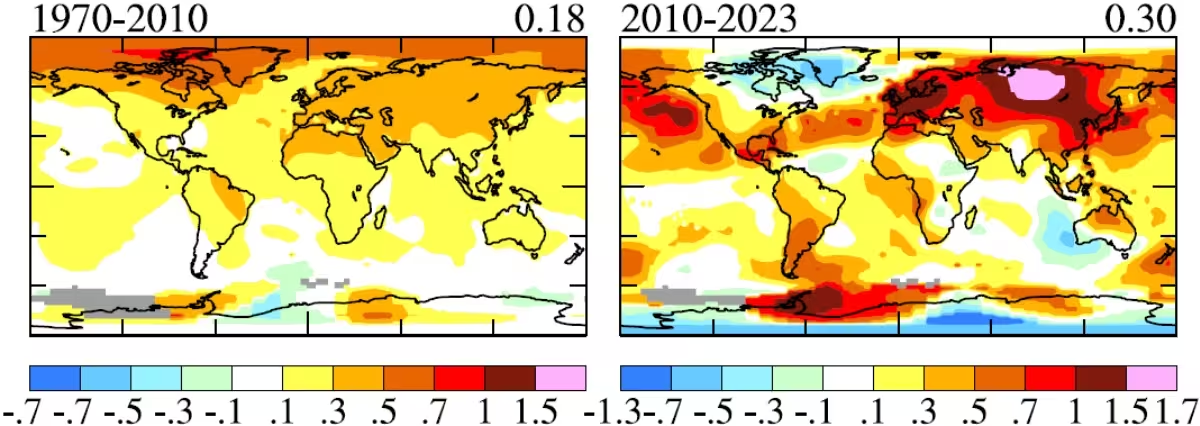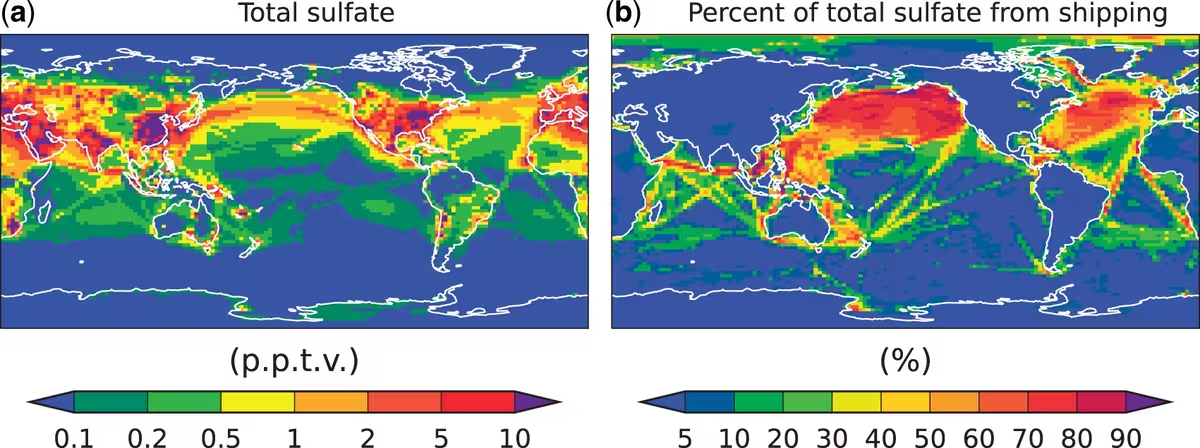Accelerated global warming linked to decreased sulfur aerosols from ships
4 April 2024
Decreasing human-made aerosols—such as due to the reduction of sulfur content in marine fuels—increased Earth’s energy imbalance and accelerated global warming in the past decade, according to a communication titled Global Warming Acceleration: Hope vs Hopium by Dr. James E. Hansen of the Columbia University. The communication confirms and reinforces the findings published last year by the same team [6138].
Accelerated global warming is the first significant change of global warming rate since 1970. It is important, the paper says, because it confirms the futility of present “net zero” energy policy. Figure 1 shows that global warming accelerated since 2010, especially in regions where aerosol forcing is believed to have declined due to the International Maritime Organization’s (IMO) marine fuel regulations.

The number in upper right corner indicates the global warming in °C per decade in the respective period
(Source: James Hansen)
Global warming in 2010-2023 is 0.30°C per decade, 67% faster than 0.18°C per decade in 1970-2010. The recent warming also has a different geographical distribution, peaking at the latitude of 30-60°N. Such an acceleration of warming does not simply “happen”—the paper argues—it implies an increased climate forcing (imposed change of Earth’s energy balance). As greenhouse gas (GHG) forcing growth has been steady, the one potentially significant change of climate forcing is change of human-made aerosols. The large warming over the North Pacific and North Atlantic (Figure 1) coincides with regions where ship emissions dominate sulfate aerosol production, Figure 2.

(Source: James Hansen [6138])
Global absorbed solar radiation (ASR) has increased dramatically since 2010, more than 1.4 W/m2, equivalent to a CO2 increase of more than 100 ppm. The ASR increase is not due to a brightening Sun, it is due to a darkening Earth caused by climate feedback (decreasing ice/snow and cloud albedo, i.e., reflectivity) and climate forcing (decreasing aerosols). The analysis in the paper infers that the forcing due to decreased ship aerosols is at least ~0.5 W/m2. A smaller, additional, forcing is inferred from increased ASR over Europe, which also is likely from reduced aerosols.
This estimate for the ship aerosol forcing is an order of magnitude (factor of ~10) greater than what follows from United Nations’ IPCC climate estimates. Climate sensitivity and aerosol forcing, physically independent quantities, were tied together by the IPCC climate assessments that rely excessively on global climate models (GCM) and fail to measure climate forcing by aerosols. IPCC’s best estimates for climate sensitivity and aerosol forcing both understate reality, according to James Hansen. Under the present geopolitical approach to GHG emissions, global warming will exceed 1.5°C in the 2020s and 2°C before 2050 [6138].
The role of aerosols in climate change has been studied by others. A study published last year in Nature Communications found that aerosol reductions significantly contribute to climate warming, increase the frequency and intensity of extreme weathers toward carbon neutrality, and that the aerosol impacts far outweigh the effects of greenhouse gases [6043].
Source: Dr. James E. Hansen